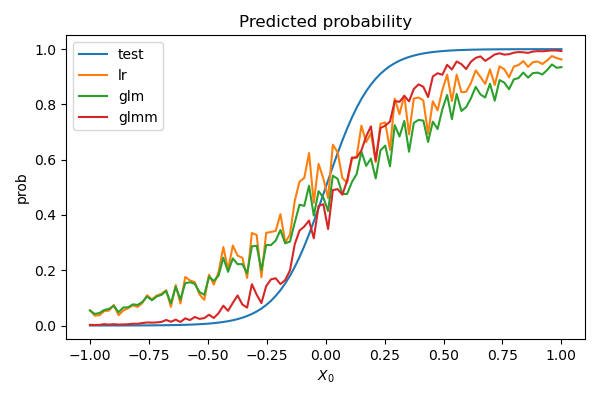I am trying to test statsmodels GLMM vs logistic regression (by either statsmodels or scikit-learn - see the code with a toy example below). I understand the utility of mixed models in parameter estimation, and that this model might be more truthful in terms of Akaike or some other criterion. However, I am not sure whether and when I should expect improvement in prediction accuracy, when testing on data coming from unknown groups.
Here is the code with a toy example:
from __future__ import division
import numpy as np
import matplotlib.pyplot as plt
import statsmodels.api as sm
from sklearn.linear_model import LogisticRegression
from sklearn.preprocessing import StandardScaler
from scipy.special import expit
seed = 2024
"""
Comparing logistic regression with GLM
"""
#Generating mixed data
n_smpls = 1000
n_feats = 5
n_groups = 100
groups = np.repeat(np.arange(n_groups), n_smpls//n_groups)
rng = np.random.default_rng(seed=2024)
X_train = np.random.normal(size=(n_smpls, n_feats))
offs = np.random.normal(size=n_groups, scale=0.5)
offsets = np.array([offs[g] for g in groups])
x0 = 0.; b = 10.
y_train = (np.random.random_sample(n_smpls) < expit(b * (X_train[:,0]-x0-offsets))).astype(np.float64)
#Generating test data
m_smpls = 100
xmax = 1.
xx = np.linspace(-xmax, xmax, m_smpls)
X_test = np.random.normal(size=(m_smpls, n_feats))
X_test[:,0] = xx
prob_test = expit(b * (X_test[:,0] - x0))
y_test = (np.random.random_sample(m_smpls) < prob_test).astype(np.float64)
#--------------------------------------------------------------------------
#scaling data
scaler = StandardScaler()
X_train_scaled = scaler.fit_transform(X_train)
X_test_scaled = scaler.transform(X_test)
preds = []
probs = [prob_test]
#--------------------------------------------------------------------------
#sklearn logistic regression
clf = LogisticRegression(random_state=seed, penalty='l2')
clf.fit(X_train, y_train)
y_pred = clf.predict(X_test)
preds.append(y_pred)
prob = clf.predict_proba(X_test)[:,1]
probs.append(prob)
#--------------------------------------------------------------------------
#Logistic regression by Statsmodels
clf = sm.GLM(y_train, X_train_scaled, family=sm.families.Binomial()).fit_regularized(L1_wt=.9, alpha=.01)
prob = clf.predict(X_test_scaled)
probs.append(prob)
y_pred = (prob > 0.5).astype(float)
preds.append(y_pred)
#--------------------------------------------------------------------------
#GLMM with statsmodels
Z_train = np.zeros((n_smpls, n_groups))
Z_train[np.arange(n_smpls), groups] = 1
glmm = sm.BinomialBayesMixedGLM(y_train, X_train_scaled, Z_train, np.arange(n_groups))
clf = glmm.fit_vb(scale_fe=True)
prob = clf.predict(X_test_scaled)
probs.append(prob)
y_pred = (prob > 0.5).astype(float)
preds.append(y_pred)
#--------------------------------------------------------------------------
#Analyzing results
fig, ax = plt.subplots(1, 1, figsize=(6, 4))
for name, prob in zip(['test', 'lr', 'glm', 'glmm'], probs):
ax.plot(xx, prob, label=name)
ax.legend()
ax.set_xlabel(r'$X_0$')
ax.set_ylabel('prob')
ax.set_title('Predicted probability')
plt.tight_layout()
plt.show()
The resulting figure is:

We see here that in terms of predicting the probability GLMM does better, but it produces the same intercept, and no improvement in the classification accuracy: one could evaluate the numbers of true/false positive and the related metrics. E.g., for true positive/negative rates one gets
[np.sum((y_pred==1)&(y_test==1))/np.sum(y_test==1) for y_pred in preds]
[0.9782608695652174, 0.9782608695652174, 0.9565217391304348]
with the results
[0.9782608695652174, 0.9782608695652174, 0.9565217391304348]
[0.9074074074074074, 0.9259259259259259, 0.9259259259259259]
